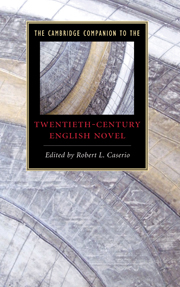Book contents
- Frontmatter
- Introduction
- 1 The art of English fiction in the twentieth century
- 2 The British Empire and the English modernist novel
- 3 Realism and rebellion in Edwardian and Georgian fiction
- 4 The Great War in English fiction
- 5 Postwar modernism in the 1920s and 1930s: The mammoth in the basement
- 6 Regionalism in English fiction between the wars
- 7 Ireland and English fiction
- 8 Feminist fiction
- 9 Working-class fiction across the century
- 10 World War II, the welfare state, and postwar “humanism”
- 11 The Windrush generation
- 12 History in fiction
- 13 Postmodernisms of English fiction
- 14 Detectives and spies
- 15 The post-consensus novel: Minority culture, multiculturalism, and transnational comparison
- 16 An absurd century: Varieties of satire
- 17 The other side of history: Fantasy, romance, horror, and science fiction
- Further reading
- Index
5 - Postwar modernism in the 1920s and 1930s: The mammoth in the basement
Published online by Cambridge University Press: 28 July 2009
- Frontmatter
- Introduction
- 1 The art of English fiction in the twentieth century
- 2 The British Empire and the English modernist novel
- 3 Realism and rebellion in Edwardian and Georgian fiction
- 4 The Great War in English fiction
- 5 Postwar modernism in the 1920s and 1930s: The mammoth in the basement
- 6 Regionalism in English fiction between the wars
- 7 Ireland and English fiction
- 8 Feminist fiction
- 9 Working-class fiction across the century
- 10 World War II, the welfare state, and postwar “humanism”
- 11 The Windrush generation
- 12 History in fiction
- 13 Postmodernisms of English fiction
- 14 Detectives and spies
- 15 The post-consensus novel: Minority culture, multiculturalism, and transnational comparison
- 16 An absurd century: Varieties of satire
- 17 The other side of history: Fantasy, romance, horror, and science fiction
- Further reading
- Index
Summary
The experimental novelists of the 1920s and 1930s had to cope with the divided legacy of the first generation of modernist writers who had pursued parallel but mutually contradictory paths. The revitalizing of tradition, and the realigning of values with an impersonal standard, were motive forces behind the cultural programming of T. S. Eliot, Ezra Pound, and Wyndham Lewis, while an antithetical investment in the fleeting moment and multifaceted solipsism were fundamental to the narrative routines of Dorothy Richardson and Virginia Woolf. The Joycean literary apparatus was virtually unique in comprehending the different strains of this Janus-faced modernism. This essay will consider the work of nine writers for whom the demands of a national cultural politics, or the issues of sexuality, gender and class, required an adaptation of the self-conscious internationalism of the earlier modernists, with their attempted transfusions of cultural experience from one historical epoch to another. One of the busiest pivots around which the debate over different philosophies of writing generated a constant heat was the critical activity of Wyndham Lewis.
For Lewis, immersion in the medium of time that was guaranteed by the use of interior monologue, or by versions of the “stream of consciousness” model derived from Bergson, was totally abhorrent. Fidelity to the spontaneous movements, the changes in direction, of thought and feeling in the experience of the individual subject, reduced the intensely psychologized versions of modernist fiction to examples of a souped-up form of realism.
- Type
- Chapter
- Information
- Publisher: Cambridge University PressPrint publication year: 2009



